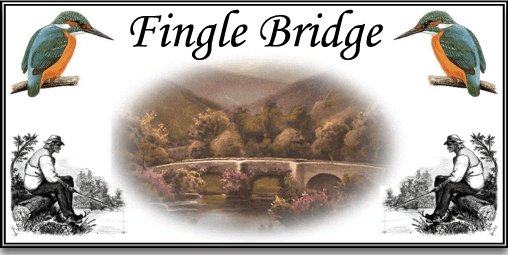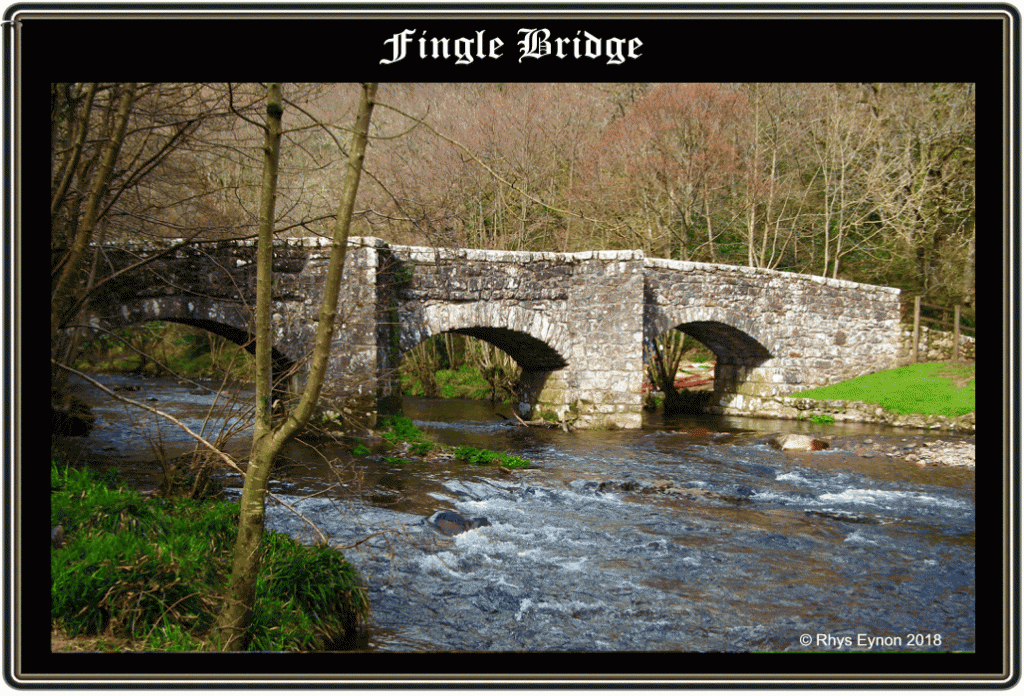
Fingle Bridge, its very name sounds like something straight from the pages of a fable story, does it not conjure up images of piskies, woodland spirits, or witchcraft? I would imagine that Fingle Bridge has been on the tourist route since the early 1800’s and the move towards the picturesque took place. As always the ideal time to visit is on a late September’s day when all the summer visitors have gone. It is at this time that the trees are turning colour and the mighty Teign is ushered rolling down an avenue of gold and orange. Back in 1893, John Lloyd Warden Page published the following description of Fingle Bridge:
“… the ancient bridge, so narrow that only one cart at a time can pass over it, and the wayfarer caught thereby must retire into one of the triangular recesses, the continuation upwards of the sharp buttresses that divide the hurrying waters. A sweet spot, though somewhat sad toward eventide, when the ‘cry’ of the river sound mournful on the darkening atmosphere“.
He must have been having a bad day when he penned the above lines because two years later, in 1895, Page waxes positively waxed lyrical about Fingle Bridge:
“How clear the rushing waters gliding beneath the three gray arches! how rich in colouring have the lichens and ferns rendered its hoary walls! and, whether we look up-stream to the hills, softly meeting one another with foliage changing from bright green in the foreground to misty blue in the distance, or downward to where the old mill with its moss-grown water-wheel, nestles beneath the woods, and Prestonbury rises mountainous over all, we shall confess that a scene of greater beauty it has never been our lot to view“.
Now, can’t you just see the genteel city folk packing their bags at such an alluring picture of the romantic and picturesque. A few years earlier in 1864 an unknown author penned a diary that was later published as ‘A Gentleman’s Walking Tour of Dartmoor’. In the dairy the author relates his visit rather different to Fingle Bridge:
“… This is a great place for Pic-Nics, indeed it is a pretty sure “find” on any day from the middle of May to the middle of August. We were there in July and found two Pic-Nics going on at once to the tune of a hideous German band the winding of whose melodious (?) horns was far more out of place, if not quite so unbearable as in those would-be quiet streets whence the magic of Bass’ is driving them.
Some premonitory drops had been warning of what to expect, and very shortly the rain came down in torrents, and we were fain to seek shelter with the dripping Pic-Nicers and draggle-tailed musicians in the picturesque old mill that lies below the bridge.
The Pic-Nicers, though damp, were affable and most kindly insisted on our drinking several glasses of their sherry…“
Today you are more likely to find modern-day, “Pic-Nicers”, being accompanied by loud rap music and slugging back cans of larger instead of glasses of sherry, and they are very unlikely to, “insist”, on your drinking several cans! So as the above descriptions points out, Fingle Bridge has a certain charm that has lured visitors for centuries. One of the other attractions of the area is that it has been famed for its excellent fishing waters with anglers coming to catch trout and salmon. You can tell how popular Fingle Bridge has been from the numerous postcards that over the years have been produced, a selection of which can be seen below.
But what is the history of the bridge? Henderson and Jervoise, note how it can be assumed that no bridge existed on the site prior to the early 1600’s. There is a record stating that in the year of 1665 the bridge was said to have been, “in decay”. The present-day bridge consists of three segmental arches carried by huge piers, the cut-waters are surmounted by recesses which as Page describes allows travellers to move out of the way should a laden packhorse come along. The distance between the two parapets is seven feet which makes the bridge one of the narrower of the moorland examples. The bridge was built to service the industries of the gorge which included corn milling, charcoal burning, bark ripping, and the supply of timber. The produce from all these industries where transported by pack-horse hence the reason for the bridge being narrow. An early sketch of 1797 by the Reverend Swete shows how the bridge looked during that period as can be seen above.
With regards the name Fingle, this is the name of a stream that rises on Whiddon Down and then descends to join the river Teign at Fingle Bridge. Glover et all, p.432 suggest the stream’s name derives from the Old English stem word, fang which means to, ‘hold or catch’. This in their opinion could allude to a bountiful fish supply found in the stream. However, there are three other alternatives, the Old English word Fengel means a ‘prince’ or ‘king’ or the alternative definition of the word Fang is – ‘plunder or bounty’. The third option is the word Fengelãd which means a ‘marsh path’ or ‘fen’, which when considering the stream could also fit. The earliest record of the place-name was in 1317 where relating to the stream it appears in the assize rolls as fenghyl which does sound remarkably like Fengel? The earliest mention of Fingle Bridge in the Duchy of Cornwall records is dated 1765.
The 1888 OS extract shows a stone situated about a hundred yards from the bridge on the Cranbrook side of the river. In fact the three foot stone bears witness to the fact that their surveyors found it by dint of a bench mark carved on its western face. There is also an incised cross on the north face it is thought that the stone possibly served as a waymarker and was reported being in-situ in 1863 by Omerod. Apparently the stone then walk-abouts for a few years but was replaced sometime after 1874. Apart from those few meagre details little else is known of the stone including its name.
About a mile and a half upstream from the bridge is a pile of rocks known as the Pixies Parlour and it was here where under the cover of darkness, an old farm labourer once caught a Piskie. After a bit of a tussle the man managed to take it back to his master only to discover in the light of a candle that he had caught the master’s son’s pet rabbit.
Again, upstream from the bridge, under Hunts tor, is what at one time was regarded as a, “mystic apparatus of Druidism”, in the form of a logan stone which sits on the river bed known as the Teign Logan. This along with the nearby Spinster’s Rock gave speculation that the whole area held some significance for the druids and that the village of Drewsteignton took its name from their presence – wrong!
Fingle Bridge recently hit the headlines when a couple got married at the Fingle Bridge Inn. Apparently this was on the bridge that ‘THE’ question was originally popped on a day visit, I know its a romantic spot but I wouldn’t have gone that far.

Barber, C. & Chard, J. 1990 Tales of the Teign, Obelisk Publications, Exeter
Butler, S. (Ed) 1986 A Gentleman’s Walking Tour of Dartmoor, Devon Books, Exeter.
Chard, Judy 1981 Along the Teign, Bossiney Books, St. Teath.
Clark Hall, J. R. 2004 The Concise Anglo Saxon Dictionary, University of Toronto Press, London.
Crossing, W. 1990 Crossing’s Guide to Dartmoor, Peninsula Press, Newton Abbot.
Crossing, W. 1987 The Ancient Stone Crosses of Dartmoor, Devon Book, Exeter.
Crossing W. 1987 Gems in a Granite Setting, Devon Books, Exeter.
Crossing W. 1986 The Teign from Moor to Sea, Quay Publications, Brixham.
Gover, J. E. B., Mawer, A. & Stenton, F. M. 1992 The Place Names of Devon, English Place-Name Society, Nottingham.
Gray, T. (Ed) 2000 Travels in Georgian Devon, Devon Books, Exeter.
Greener, P. 2000 Drewsteignton Millennium Picture Book, Drewsteignton Parish Council.
Henderson, C. & Jervoise, E. 1938 Old Devon Bridges, Wheeton & Co. Exeter.
Page, J. Ll. W. 1893, The Rivers of Devon, Seeley& Co, London.
Page, J. Ll. W. 1895 An Exploration of Dartmoor, Seeley and Co, London.
Sandles, T. 1997 A Pilgrimage to Dartmoor’s Crosses, Forest Publishing, Liverton.
 Legendary Dartmoor The many aspects past and present of Dartmoor
Legendary Dartmoor The many aspects past and present of Dartmoor




